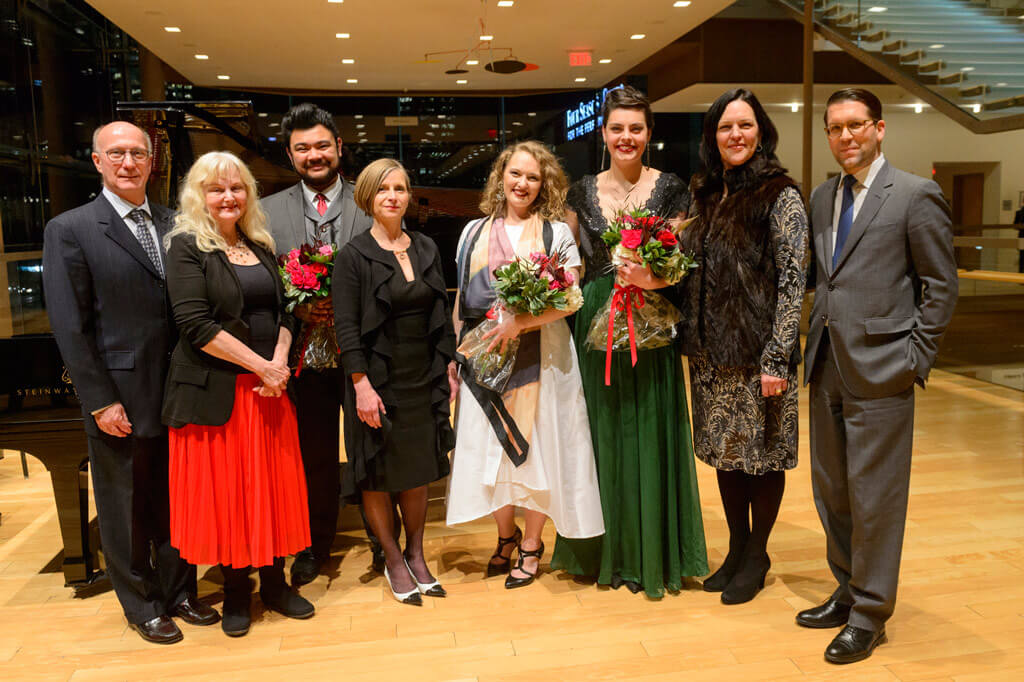
Last evening, I attended the Christina and Louis Quilico Awards at the Four Seasons Centre. This Award is designed to showcase the talents of the Canadian Opera Company’s Ensemble Studio members. Currently, there are ten members in the Ensemble — eight singers and two pianists. Seven of them participated last evening — soprano Danika Lorèn, mezzos Emily D’Angelo and Lauren Eberwein, tenor Charles Sy, and baritone Bruno Roy. Tenor Aaron Sheppard, originally scheduled to perform, withdrew due to illness. The two pianists were at the keyboard but not part of the competition. The two remaining Ensemble members, soprano Samantha Pickett and mezzo Megan Quick, were not contestants.
The three members of the jury panel were COC General Director Alexander Neef, COC Chorusmaster Sandra Horst, and Canadian soprano Adrianne Pieczonka. Each candidate had prepared three arias, typically of different styles designed to showcase the versatility of the singer. Two out of the three were performed, one was the singer’s choice, the other chosen by the jury panel.
Emily D’Angelo opened the proceedings with an effervescent “Non piu mesta” from La cenerentola, followed by “Coeur sans amour” from Cendrillon. D’Angelo rose to fame last year when she won the Metropolitan Opera Auditions, so arguably she has the highest international profile among the five competitors. She did not disappoint in this competition, singing with sparkling tone and easy coloratura. Tall and statuesque, not to mention possessing a million-dollar smile, these are the “intangibles” that makes a young artist special in the eyes of the judges and the audience.
She was followed by Bruno Roy, who sang Pelleas’s monologue from Pelleas et Melisande. His light, high baritone suits the role of Pelleas, which can be sung by either a baritone or tenor. And he sang it mellifluously and musically. The same can be said for the imposed piece, Harlequin’s arioso from Ariadne auf Naxos, a lyric baritone’s bread and butter piece. These two showed off his very nice and compact light baritone, but I would stick my neck out and say that these rather subtle pieces are not quite the showstoppers that make one sit up and pay attention in a competition.
The intermission was cancelled due to the illness of Sheppard, so we went straight to tenor Charles Sy, who began with “I must with speed amuse her” from Semele. I was bowled over by his agility – I had no idea he could move his voice so fast – bravo! I’ve been following his career when he was a student at the U of T opera school, and Sy is singing better than ever. His tenor is warm, clear, and well modulated, with quite a heft to his sound. I keep thinking that with maturity, he may become a spinto. For now, he is a very fine lyric tenor. His second piece, “Lève toi soleil” from Romeo et Juliette is a terrific choice, and he sang it with lovely tone and dramatic urgency. This tenor will go far.
Next up was mezzo Lauren Eberwein. Hers is a high mezzo, with a pleasantly cool timbre. She began with “Wie du warst” — excerpted from the Act One scene between Octavian and the Marschallin in Der Rosenkavalier. I absolutely love this opera, and Octavian has great music to sing, but I don’t understand why this is so popularly excerpted as a showpiece for high mezzos in competitions. I keep expecting the Marschallin to come in! To my ears, it puts the singer at a disadvantage in a competition, especially in a non-German speaking country like Canada. She sang well, perhaps with not a full spectrum of tone colours, but it was a fine performance. Her Adalgisa’s aria from Norma – again beautifully sung, but it’s another slow and introspective piece — I kept thinking, where’s the cabaletta?
The final contestant was soprano Danika Loren. I’ve heard her several times at the U of T Opera School, and I’ve seen her in masterclasses as well. I’ve always felt she has a great deal of potential. Since entering the Ensemble this fall, she has been singing better than ever. In January, at the COC Season Launch, she sang a dynamite “Caro nome” that made everyone sat up and took notice. She reprised it at the competition, and it is every bit as good, with gorgeous, crystalline tone, great staccati and everything in between. Brava! Her Ariodante was also very fine. Both arias show that her high lyric with coloratura – as opposed to a true coloratura soprano — is ideal in both baroque or a bel canto role like Gilda.
With the competitors finished, the jury retired to deliberate. I must say it took a lot longer than I thought they would. In the end, the result was no surprise as to the winners, but surprising in that there was a tie! First Prize ($5,000) was not awarded. Instead, we have two Second Prizes ($4,000 each, up from $3,000), to D’Angelo and Lorèn, both very deserving. Third Prize ($2,000) went to tenor Charles Sy. I should say all three were enormously talented artists and perfectly capable of winning, and they were fully deserving. We will be hearing more from them in the future.
For more CLASSICAL MUSIC NEWS, visit HERE.
#LUDWIGVAN
- SCRUTINY | Opera Atelier’s All Is Love Makes Triumphal Return - April 15, 2024
- SCRUTINY | From The Heart: Ema Nikolovska And Charles Richard-Hamelin Offer Unique Program At Koerner Hall - March 26, 2024
- SCRUTINY | The Glenn Gould School Spring Opera Presents A Superb Dialogues Des Carmélites - March 22, 2024



